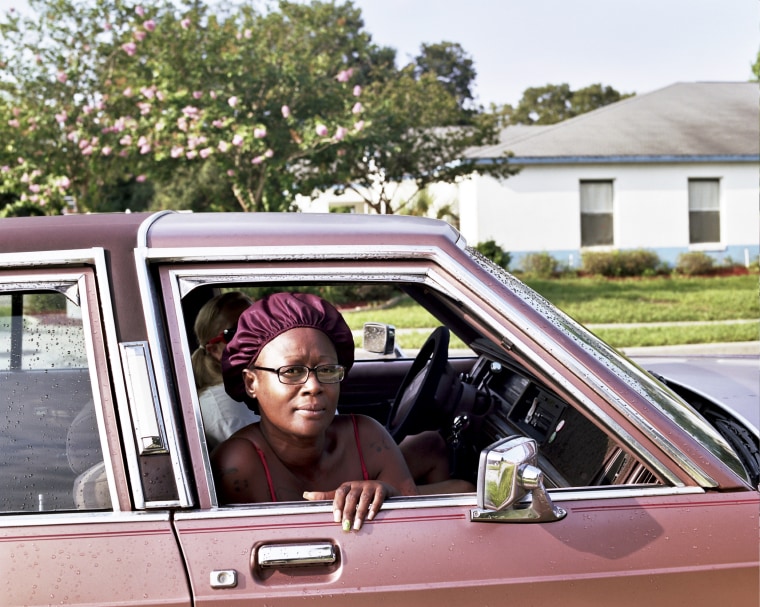Last summer, as the nation awaited a verdict in the murder trial of George Zimmerman for the shooting death of Trayvon Martin, msnbc reporter Trymaine Lee and award-winning photographer Wayne Lawrence spent time in the historic African-American community of Goldsboro, not far from where Martin was killed, to examine the social and economic state of the neighborhood before and after the teen’s death.
In interviews and images, the people of Goldsboro tell their stories of struggle, resilience and what’s it’s like to be black in Sanford.
It’s been two years this week since 17-year-old high school student Trayvon Martin was shot to death in Sanford, Fla. And just about seven months since his killer, George Zimmerman, was acquitted of murder charges in Martin’s death.
Zimmerman claimed he killed the unarmed teen in self-defense. Over the summer, a jury of six believed him, clearing him of any wrongdoing in Martin’s death. While the criminal case against Zimmerman was put to bed with the verdict, the broader social implications of the case continue to ripple from Sanford and beyond.
But long before Martin’s killing sparked anger and protests across the country and drew thousands to this central Florida city once known as the “Celery Capital of the World,” Sanford’s black communities had been wrestling with racial strife and economic inequality.
Like so many other American towns, Sanford is two largely distinct worlds: one white and one black. Most of Sanford’s African-American residents live in a handful of neighborhoods like Goldsboro and Midway, where employment opportunities are few and poverty and hopelessness run high. Violence, including gunfire, is common. And many black residents complain of harsh, unfair treatment by the police.
It was in Goldsboro, a community haunted by generations of segregation and oppression, that the first protests after Martin’s killing began.
Related: Reporter Trymaine Lee takes your questions
Income and achievement gaps in Sanford have widened in the decades since Civil Rights era victories had theoretically thinned the boundaries between the races. And more recent efforts to highlight and celebrate the vast contributions of Sanford’s black community have been a welcomed respite from a history fraught with as much pain as hope.
But race relations in Sanford and in the Goldsboro neighborhood in particular are especially thorny. Henry Shelton Sanford, an American diplomat who served in the Congo, founded Sanford in 1870 and later argued that America would be better off if blacks were returned to Africa.
In 1891 Goldsboro was incorporated and became the second all-black town incorporated in the state, after Eatonville, the town made famous by author Zora Neal Hurston in “Their Eyes Were Watching God.”
But in 1911 Sanford expanded and stripped Goldsboro of its charter, absorbing the city into Sanford proper.
Goldsboro’s institutions were dismantled, including the post office, the jail and many of the black-owned businesses. Streets named for Goldsboro’s black founding fathers were changed to numbers instead.
In 1946 Sanford’s police chief famously forced Jackie Robinson out of a minor-league baseball game, refusing to let him integrate the exhibition. “The Robinsons were run out of Sanford, Fla., with threats of violence,” Robinson’s daughter, Sharon Robinson, later wrote. During the Civil Rights era, city leaders cemented over Sanford’s lone public pool rather than allow black children to swim in it.
In more recent years there have been controversies around police shootings involving unarmed black men and a string of homicides that remain unsolved: many locals believe that police don’t expend resources investigating killings with black victims.
Much of Sanford is the stuff of postcards, with red-bricked streets downtown and a picturesque waterfront. Crooked oak and willow trees hunch over lazy roads. Further away from downtown are the fruits of Sanford’s more recent sprawl, with newer developments similar to the gated community where Martin was killed in 2012 by George Zimmerman, a former neighborhood watch volunteer.
It was along 13th Street, recently renamed Historic Goldsboro Blvd. where anger over Martin’s killing first spilled over. The homegrown protests were fueled by anger at the death of an unarmed boy just past his 17th birthday, but also by decades of frustration in this besieged community.
